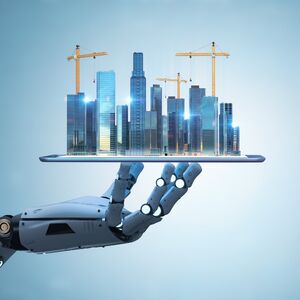Technologies and construction
20.06.2023

Today, technology is having an impact in all fields, including construction, and on several levels: building materials, work methods and the tools used by people working in the field. For each of these areas mentioned above here are a few examples of the evolution brought about by technology.
Building materials:
Working methods:
Tools:
Sources
PlanRadar - Article
Empa - Article
ChatGPT
Building materials:
- Self-healing concrete: a type of concrete that has the ability to repair itself autonomously. This is made possible by adding capsules containing bacteria and nutrients (or specific polymers) to the concrete. Once a crack forms and moisture reaches these capsules, they activate to fill the cracks, restoring the concrete's strength.
- Aerogel bricks: these translucent bricks offer optimum insulation while allowing natural light to illuminate a room. Unlike traditional glass bricks, aerogel bricks can be used as load-bearing walls, while retaining a degree of privacy since they are not totally transparent.
- Fiber composites: Fiber composites, such as carbon fiber or glass fiber, are increasingly used in construction. They offer greater strength, lightness and durability than traditional materials. They are used in the manufacture of load-bearing structures, facades, bridges and other structural elements.
Working methods:
- Building Information Modeling (BIM): BIM is an approach based on 3D modeling and integrated data. It enables the various players in a construction project (architects, engineers, contractors, etc.) to collaborate effectively and share accurate information throughout a building's lifecycle. BIM facilitates coordination, reduces errors and costs, and improves overall productivity.
- Reality Capture: reality capture is a technology that creates accurate 3D models from field surveys, laser scans and images. These models can be used for planning, visualization, conflict detection and project management. Augmented reality (AR) and virtual reality (VR) are often used in conjunction with reality capture to deliver immersive experiences and improve communication between construction teams.
- Online collaboration solutions: online collaboration platforms enable construction teams to share documents, work on plans, collaborate on designs, communicate and coordinate tasks remotely. This facilitates collaboration between field workers, engineers, architects and other stakeholders, even if they are not physically present on site.
Tools:
- 3D printing: 3D printing is used in construction to manufacture structural elements, prefabricated components, and even complete buildings. This technology reduces construction times, minimizes waste and enables the production of complex shapes that would otherwise be difficult to achieve. 3D printing also offers more creative and customized design possibilities.
- Drones: Drones are used in construction for aerial surveying, site surveillance, structural inspection and site mapping. They can provide high-resolution images and video, as well as precise geospatial data, enabling improved planning, resource management and safety on construction sites.
- Exoskeletons: these mechanical structures can be worn by workers during demanding tasks, reducing muscle fatigue, preventing injuries associated with heavy loads and improving worker productivity in the field. They are also designed to reduce the risk of musculoskeletal disorders among workers.
Sources
PlanRadar - Article
Empa - Article
ChatGPT


